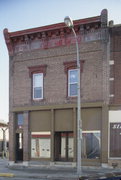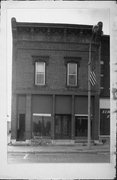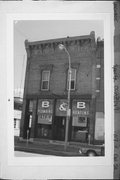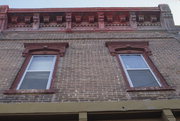| Additional Information: | Historically, this lot started out as an alleyway, but in 1890, a substantial brick building appeared at this location. This building is the present building and it was owned by George and William Hoffman and opened as Hoffman Brothers meat market. This building was an improvement over their former headquarters next door at 115 East Oak Street.
W.C. Hoffman was the brother of George Hoffman, a prominent butcher in Sparta. George Hoffman came to Sparta in 1876, where he began to learn the butcher trade from O.D. Stevens. Later, George Hoffman became associated with his brother William and together they acquired the William Potter butchershop on Water Street. By 1888, the Hoffman Brothers had moved to East Oak Street because they advertised that they were opposite the American House Hotel. On East Oak Street, they dealt in meat, fish, poultry. They also noted that they had a superior ice box for preserving meat in warm weather. In 1890, Hoffman Brothers butchershop moved into this new building, where they did businessuntil sometime after 1904.
From 1894 to 1904, it remained the Hoffman Brothers meat market, and the Hoffman family upstairs. In 1916, ownership of the butchershop changed to J.F. Hollenbeck and Dell Streeter. Hollenbeck also then lived on the premises. It remained a meat market until at least 1922.
The Hoffman Meat Market Building gains local significance under Criteria A i association with Sparta's Industrial Theme under the topics Meats Products. The meatpacking business contributed substantially to Sparta's economy over a long period of time in the form of meatpacking plants and butcher shops. The Hoffman Brothers Meat Market contributed to Sparta's economy substantially. The building's period of historical significance ranges from its erection and initial business occupation in 1890 to the early 1920's, when the butchershops at this location can still be documented. In addition, the Hoffman Meat Market Building gains local significance under Criterion B because the building was erected by George and William Hoffman, longstanding successful and prominent owners of an important butchershop. The name Hoffman appears on several other buildings in the community of Sparta.
This Italianate styled two-story red brick comemrcial building is characterized by a massive projecting bracketed iron cornice ornamented by large end brackets, block modillions, a row of dentils and a paneled freize. Projecting iron window heads featuring a recessed shouldered arch with articulated keystone topped by a small cornice are enframed in the recessed brick panels on the upper facade. An iron storefront displaying a full-length iron lintel resting on iron pillars or shafts that flank the central recessed entrance is located on the lower story. The storefront is characterized further by an entrance to the upper story topped by a transom window in the east bay and transom covered by wood paneling in the west bays.
This small retail building, while continuing to display much of its original Italianate influenced architectural character, has been altered by the replacement metal windows on the upper story and by the alteration of the plate glass window and transom on the storefront.
Constructed in 1890, this building was built for W.C. Hoffman. Hoffman had this two-story brick building, 25 ft x 80 ft, constructed on the lot adjacent [east side] to his earlier meat market. Hoffman's previous market was a one-story frame building located at 113-115 East Oak before the present market was a one-story frame building site in 1899. Originally used to house Hoffman Hoffman's meat market business known earlier in the 1870s as the Hoffman Brothers Market, this building continued to be used as a meat market at least until the 1920s. It remained the property of the Hoffman family until at least the 1930s.
The Hoffman Meat Market is significant under Criterion C as an example of the Italianate style. This small commercial building is among the best preserved of the 13 examples of the Commercial Italianate style in the proposed water Street Historic District. In addition to the prerequisite iron cornice and ornamental window heads associated with the Italianate style, the Hoffman Meat Market building is the only building in the district that continues to display its iron storefront. Other well-preserved examples are located at 118 South Water (MO23/35), 120 South Water (MO23/35), and 144 North Water (MO36/14). |
|---|
| Bibliographic References: | (A) Monroe County History Room, Rt. 2, Sparta, WI, Photograph Collection, Photograph #1184.
(B) City of Sparta Tax Records, 1882-1930.
(C) Sparta Herald, Aug. 5, 1890; Sept. 30, 1890; April 11, 1899; June 13, 1923.
(D) Sanborn Insurance Maps 1884, 1889, 1894, 1900, 1911, 1922, 1931.
(E) City of Sparta Tax Rolls, 1870-1940.
(F) Annual Directory of Sparta, Wisconsin. Vol. 1. Chicago: Interstate Directory Co., 1897.
(G) Sparta City Directory, 1903-1904. Sparta: R.C. Glover, Publisher, 1904.
(H) City Directory of the City of Sparta, Wisconsin. Sparta: compiled and published by E.B. Bell, 1916.
(I) Sparta Democrat Sept. 19, 1890; May 15, 1891.
(J) Koehler, Lyle P., From Frontier Settlement to Self-Conscious American COmmunity: A History of One Rural Village (Sparta, Wisconsin) in the Nineteenth Century. Evansville, Indiana: Unigraphic, Inc., 1977, p. 64.
(K) Ellsworth, C.S., Views in and Around Sparta, Giving a Brief History of the City and Setting Forth its Advantages for Manufacturing and as a Place of Residence Together with some Account of its Celebrated Magnetic Mineral Water. Portage, Wisconsin: Register Printing Company, 1888, p. 42.
(L) Barney, Tyler Davis, "A History of the Growth of Sparta, Wisconsin, 1850 to 1890." B.A. Thesis. University of Wisconsin, 1922, p. 41.
(M) Gregory, John G., West Central Wisconsin: A History. Vol. 2, Indianapolis: S.J. Clarke Publishing Company, 1933, p. 451. |
|---|




